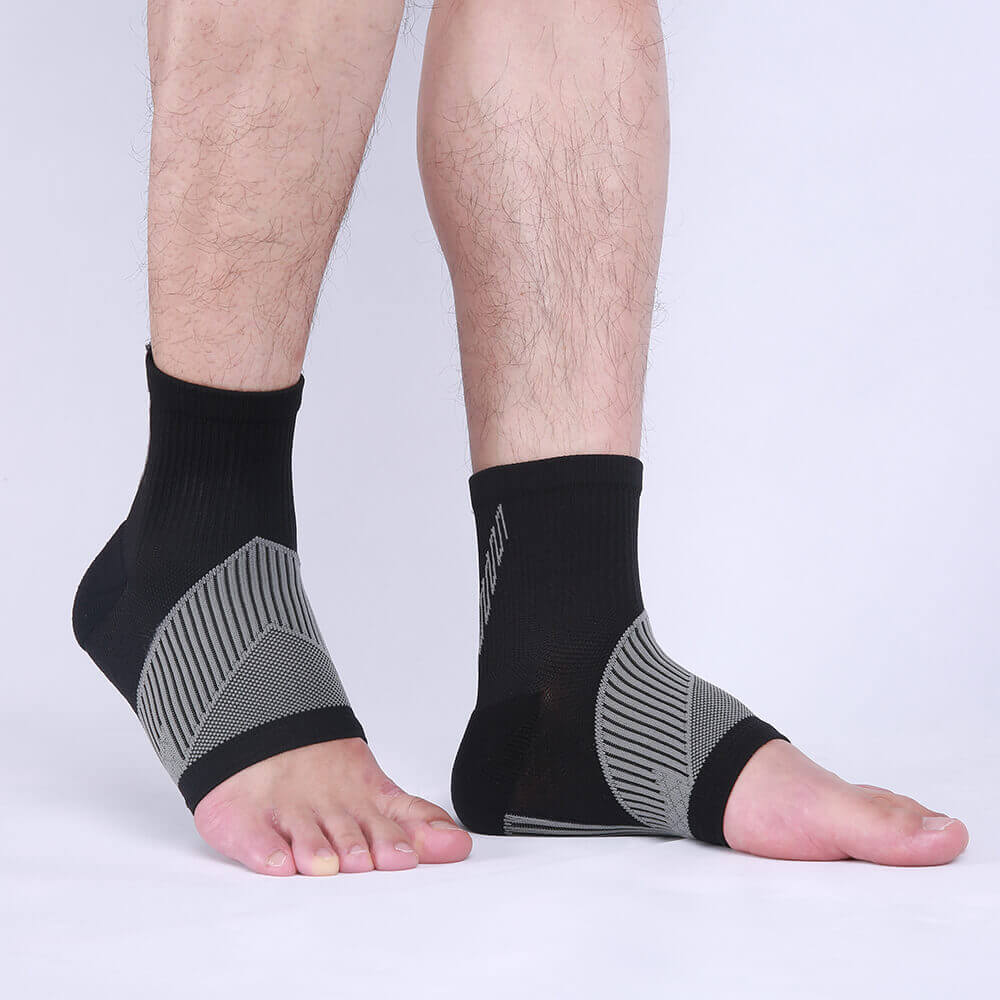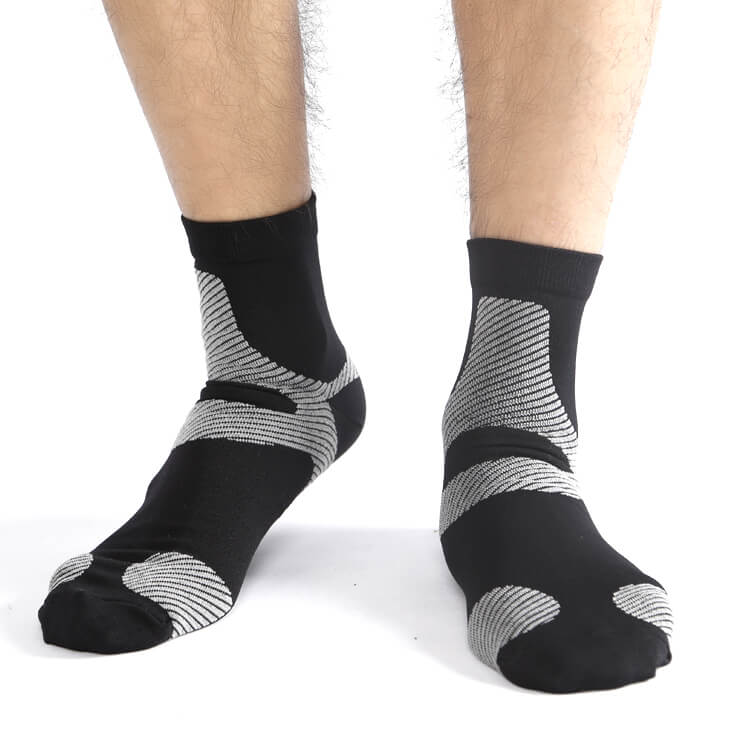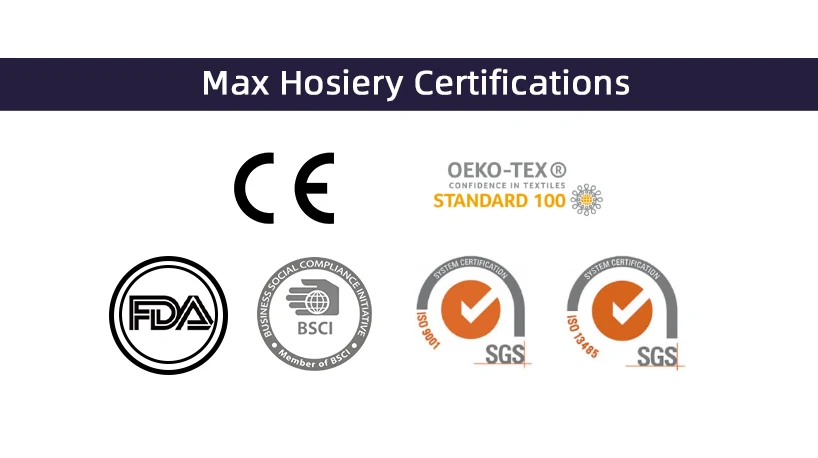Introduction: The Role of Compression in Ankle Injury Recovery

Reducing Swelling and Inflammation
After an ankle injury, the body’s inflammatory response kicks in to protect damaged tissues. However, excess fluid can accumulate around the joint, causing pain and stiffness. Graduated compression applies firmest pressure at the ankle and gradually less toward the calf. This gradient helps drive excess fluid out of the injured area and into general circulation, where the lymphatic system can process it. By limiting fluid buildup, compression socks or sleeves help control swelling in the first critical days after injury.
Enhancing Blood Flow and Oxygen Delivery
Effective healing requires efficient delivery of oxygen and nutrients to injured tissues. Compression garments support venous return—pushing deoxygenated blood back toward the heart and preventing pooling in the lower leg. Improved circulation brings fresh, oxygen-rich blood into the ankle, accelerating cellular repair. Patients often report reduced bruising and faster recovery when they combine compression with rest and elevation.
Managing Pain and Stability
An injured ankle can feel unstable, and pain receptors fire as swollen tissues press on nerves. By supporting the joint and surrounding soft tissues, compression reduces micro-movements that aggravate pain. The gentle, constant pressure also provides proprioceptive feedback—your brain senses the compression and interprets it as added stability. Many find that wearing compression socks during the day reduces reliance on heavier braces or pain medication.
Understanding Ankle Injuries: Types and Recovery Timelines
Sprains and Ligament Damage
Ankle sprains—tearing or overstretching of ligaments—are the most common injury. Recovery depends on severity: Grade I (mild) often heals in 1–2 weeks; Grade II (partial tear) requires 3–6 weeks; Grade III (complete tear) may take 8–12 weeks or need surgical repair. During each phase, compression needs shift: firmer compression early on to control swelling, then lighter support as stability returns.
Fractures and Bone Healing
Ankle fractures range from hairline cracks to displaced breaks requiring surgery and hardware. Bone healing typically spans 6–8 weeks, but soft-tissue recovery can continue longer. Immediately post-injury or post-op, medical bandaging and a cast limit motion. Once cleared for weight-bearing, graduated compression socks help manage post-cast swelling and protect healing tissues.
Post-Surgical Rehabilitation
Surgeries—from arthroscopy to internal fixation—introduce additional trauma that must heal. Initial phases focus on fluid control and soft-tissue repair, where medium to high compression (20–30 mmHg) is often prescribed. As you progress through physical therapy, compression transitions to lighter grades (15–20 mmHg) to support mobility without restricting range of motion.
The Science Behind Compression: How Graduated Pressure Aids Healing
Vein Valve Function and Venous Return
Veins contain one-way valves that prevent blood from flowing backward. Injury and swelling can overwhelm these valves, causing blood to pool. Graduated compression firms up the vein walls, helping valves close more effectively and propelling blood upward. Enhanced venous return reduces pressure on the injured ankle and supports nutrient exchange at the tissue level.
Lymphatic Drainage Enhancement
Beyond veins, compression affects lymphatic vessels—the body’s drain for interstitial fluid and waste. By gently squeezing the limb, graduated pressure stimulates lymph flow away from the injury site. Reduced lymph stagnation lowers inflammation markers and promotes a cleaner cellular environment, which speeds tissue repair.
Cellular Mechanotransduction
At the microscopic level, certain cells respond to mechanical forces. Fibroblasts and endothelial cells detect the pressure from compression fibers and upregulate growth factors involved in collagen formation and blood vessel repair. This mechanotransduction effect means compression doesn’t just move fluid—it actively signals cells to rebuild tissue more efficiently.
Timing Matters: When to Start Using Compression After Injury
Acute Phase Application
In the first 48–72 hours post-injury, the primary goal is to limit hemorrhage and swelling. RICE (Rest, Ice, Compression, Elevation) protocols recommend light to moderate compression immediately—usually via an elastic bandage or short-stretch wrap. Transition to graduated compression socks only after initial bleeding and heavy swelling subside, typically around day three or four.
Transition from Bandage to Socks
Once the acute phase passes and pain is under control, switch to compression socks or sleeves. Ensure the ankle is dry and free of dressings. Choose a sock with a comfortable opening or zipper if you still have limited mobility. Graduated compression ensures continued support without the uneven pressure of wraps, reducing the risk of fluid re-accumulation.
Long-Term Wear and Weaning
As recovery progresses into the subacute and remodeling phases (weeks 2–8), wear compression during activities—walking, standing, or light exercise—to maintain support. Remove socks for sleep unless otherwise advised by your provider. By 8–12 weeks, many can reduce to intermittent use—during prolonged standing or sports—and eventually phase out compression altogether as strength and stability return.
Choosing the Right Pressure: Optimal mmHg Levels for Ankle Recovery
Low to Moderate Compression (15–20 mmHg)
For most mild to moderate ankle sprains and post-cast swelling, 15–20 mmHg graduated compression offers gentle support without constricting blood flow. This level helps control lingering edema, provides proprioceptive feedback to stabilize the joint, and feels comfortable for all-day wear. In the early subacute phase (days 4–14), many patients find they can walk more confidently with this pressure while still experiencing minimal tightness.
Moderate to Firm Compression (20–30 mmHg)
When soft-tissue trauma is more severe—such as Grade II sprains, hairline fractures healing without surgery, or significant post-operative swelling—20–30 mmHg delivers firmer graduated pressure. It excels at reducing fluid buildup around pins or incisions and can be worn during physical therapy sessions. Because this range feels noticeably tighter, it’s best to try socks with a zipper or donning aid to ease application, ensuring the correct fit without overstretching the material.
High Compression (30–40 mmHg)
Thirty to forty mmHg compression is typically reserved for serious venous insufficiency, deep vein thrombosis risk, or extensive surgical repair. Its firm pressure can limit swelling more aggressively, but it also requires precise sizing and a physician’s prescription. Only consider this level if your healthcare provider recommends it, since too much pressure on an acutely injured ankle can impede circulation or cause discomfort.
Open vs. Closed Heel: Design Considerations for Ankle Injuries
Benefits of Open-Heel Designs
Open-heel compression socks leave the heel exposed, reducing bulk around the ankle and allowing for better mobility and airflow. This design makes it easier to fit around bulky bandages or braces. Many find that open-heel styles slip on more easily when dexterity is limited, and the uncovered heel reduces heat build-up during longer wear.
Advantages of Closed-Heel Designs
Closed-heel socks provide uniform compression around the entire foot and ankle, which can improve overall circulatory support. A snug fit around the heel prevents the sock from riding down and helps maintain consistent graduated pressure. For post-operative patients with minimal dressings, closed-heel socks offer a sleek, uniform look under pants or long braces.
Ankle Sleeves and Specialized Products
Compression sleeves cover only the calf and ankle, slipping on like a sleeve over the lower leg. They work well when foot or toe coverage irritates an injury or incision. Some sleeves feature targeted ankle pads or silicone grips to support lateral stability. Other specialized wraps combine adjustable straps with compression fabric, giving customizable tightness around ligament-injured areas.
Material Selection: Comfort and Support During Extended Recovery
Breathable, Soft Fabrics

Recovery can span weeks or months, making comfort paramount. Look for socks woven from microfiber blends that balance stretch with moisture-wicking. These fabrics allow heat and sweat to escape, reducing the risk of skin maceration beneath the sock. Soft yarns minimize friction on fragile or shaved skin, helping you wear compression longer without irritation.
Anti-Microbial and Hypoallergenic Options
In a post-surgical or post-cast environment, skin can be sensitive and prone to infection. Compression garments treated with anti-microbial finishes resist bacterial growth, which helps keep skin healthier. Hypoallergenic fibers—such as bamboo blends or medical-grade nylon—reduce the chance of contact dermatitis. Always patch-test new materials before full-day wear.
Durability for Long-Term Use
Extended recovery places repeated stress on fabric. Select brands with reinforced heels and toes to prevent early wear. Double-stitched seams resist unraveling when donning over ankles that can’t fully bend. Check manufacturer guidance for wash-cycle limits and replace your socks when elasticity declines to ensure consistent compression.
Application Techniques: Putting on Compression Socks with Limited Mobility
Using Donning Aids and Gloves
When ankle flexion is uncomfortable or swelling limits reach, a donning aid—often a plastic funnel-shaped device—can pull the sock into place without straining. Slip the sock over the aid, then use gloved hands (medical or rubber gloves provide grip) to gradually pull the fabric up the calf. The smooth surface of the aid prevents overstretching and protects delicate fibers.
Assisted Application Strategies
If self-application remains challenging, enlist a caregiver. Have them turn the sock inside out to the heel, guide your foot in, and unroll upward. Using a chair with an elevated footrest keeps you comfortable during the process. Clear communication—such as counting down to each pull—helps both parties synchronize movements and avoid jerking.
Timing and Preparation
Apply compression first thing in the morning, before fluid pools in the injured ankle. Ensure your skin is clean and fully dry. If swelling is severe, slide on a light, elastic wrap for the first two or three days, then transition to a graduated sock once initial bruising and heat subside. Proper timing makes the application smoother and maximizes therapeutic benefit.
Daily Wear Protocol: Maximizing Healing Benefits
Optimal Wear Duration
For most ankle injuries, wearing compression socks for 8–12 hours daily delivers the best balance between support and skin recovery. Slip them on first thing in the morning—before fluid has pooled in the joint—and remove them before bed to allow your skin to breathe overnight. If you’re particularly active or notice increased swelling during the day, you can extend wear slightly, but always give your skin a break for at least two uninterrupted hours.
Activity-Based Adjustments
Match your compression use to your daily routine. During periods of prolonged standing or walking—such as work shifts or errands—keep socks on to maintain consistent pressure. If you switch to seated desk work or rest, you can remove them briefly and elevate your foot. For exercise or physical-therapy sessions, wear your compression socks throughout the activity and for 30–60 minutes afterward to sustain circulation gains achieved during movement.
Overnight and Rest Considerations
Most practitioners advise against overnight wear unless specifically prescribed, as sustained pressure on a supine ankle can restrict circulation when lymphatic drainage slows. However, if you wake with significant stiffness or puffiness, light, low-profile socks (15–20 mmHg) worn for the first hour after rising can help kick-start fluid movement. Always monitor skin color and comfort—if numbness or tingling develops, remove socks immediately.
Combining Therapies: Compression with Other Recovery Modalities
Elevation and Ice Therapy
Elevation and ice remain cornerstones of acute-phase recovery. After icing your ankle for 15–20 minutes, follow up with compression to trap the cold effects and limit re-accumulation of fluid. Elevate your leg above heart level while wearing socks to use gravity in concert with graduated pressure, optimizing lymphatic drainage and reducing inflammation.
Physical Therapy and Mobilization
As you progress into the subacute phase, gentle mobilization and physical therapy exercises help rebuild strength and range of motion. Wear compression during therapy sessions—to support the joint and enhance proprioceptive feedback—but remove them for deep-water immersion or aquatic therapy, where water pressure assumes the compression role. Reapply immediately afterward to sustain therapeutic effects.
Medication and Topical Treatments
Non-steroidal anti-inflammatory drugs (NSAIDs) and topical analgesics can alleviate pain during recovery. Apply creams or gels before donning socks, ensuring the product fully absorbs to prevent fabric breakdown. Compression then helps distribute medication locally by promoting microcirculation, potentially improving symptom relief and tissue healing.
Progression Through Recovery: Adjusting Compression as Healing Advances
Acute to Subacute Transition
In the first two weeks post-injury, medium-grade compression (20–30 mmHg) often provides ideal fluid control and support. As swelling diminishes around week three or four, you can shift to lighter compression (15–20 mmHg) to encourage increased mobility without losing all support. Always reassess fit—re-measure if your calf or ankle size changes more than 1 cm.
Rehabilitation and Activity Resumption
Once you begin strength and balance exercises around weeks 4–8, maintain compression during workouts and remove it immediately afterward to let your ankle cool and the skin recover. If full activity resumes by week 8–12, consider intermittent compression: use socks only during high-impact activities, long standing, or extensive walking to prevent new swelling while allowing natural tissue loading.
Weaning Off Compression
By three to four months, most soft-tissue healing is complete. Gradually reduce compression use to low-risk scenarios—long flights, sports games, or when you anticipate prolonged standing. Store your socks conveniently so you can reintroduce support if you notice any stiffness or swelling returning. Complete weaning typically occurs by month six, with compression reserved for preventative or occasional use thereafter.
Beyond Recovery: Preventive Use After Healing
Transition to Activity-Specific Compression
Once your ankle has healed, you no longer need full-time graduated support. Instead, select compression socks designed for your next activities. If you return to high-impact sports—basketball, soccer, or trail running—opt for 20–30 mmHg socks during play and recovery. For long work shifts that require standing or walking, 15–20 mmHg offers enough support without feeling overly tight. Tailoring compression to specific events ensures you benefit from improved circulation and reduced fatigue exactly when you need it.
Monitoring for Re-Injury Signs
Even after full recovery, ankles remain vulnerable to twists, strains, or swelling if overloaded. Use compression socks as an early warning system: if you feel unusual tightness, heaviness, or mild swelling during activity, put socks on right away. The graduated pressure will help keep fluid from pooling and limit minor inflammation before it worsens. Checking your skin and joint response after each session helps you recognize patterns and adjust training loads or sock use accordingly.
Long-Term Vascular Health
Compression therapy offers more than injury prevention. Graduated pressure keeps calf muscles engaged, supporting vein valve function long after healing. For people prone to mild edema, varicose veins, or circulation issues, using 15–20 mmHg socks during travel, pregnancy, or extended standing can maintain vascular health and comfort. Integrating compression into your routine—on long flights, during sports seasons, or while gardening—can become a simple, proactive habit that protects your ankles and legs for years.
Professional Guidance: When to Consult Healthcare Providers
Recognizing Red Flags
Not all ankle pain or swelling responds to self-care. Seek medical attention if you notice persistent redness, warmth, or severe pain in one area; if swelling is asymmetric or rapidly worsening; or if you experience numbness, tingling, or skin color changes. These signs can indicate deep vein thrombosis, infection, or compartment syndrome—conditions that require immediate evaluation.
Prescription vs. Over-the-Counter Compression
Over-the-counter socks cover most mild to moderate needs. However, your provider may prescribe higher compression (30–40 mmHg) or custom-fitted garments after complex fractures, surgical reconstruction, or vascular surgery. A specialist can measure your leg precisely, advise on donning techniques, and monitor for skin or circulation issues, ensuring safe use of strong compression.
Integrating Compression into a Treatment Plan
In rehabilitation settings, compression is one component among several. Physical therapists and sports medicine physicians can advise on combining compression with targeted exercises, manual lymphatic drainage, or modalities like ultrasound. They can guide you on when to increase activity intensity, when to adjust compression levels, and how to progress toward full function without setbacks.
Conclusion

Compression socks play a vital role in the recovery process after an ankle injury. From reducing swelling and improving circulation to supporting tissue repair, they help manage pain and speed healing. Choosing the right compression level, timing, and design tailored to your injury and lifestyle ensures the best outcomes. As your recovery progresses, adjusting compression use supports a smooth transition back to daily activities and helps prevent re-injury. While many people can manage compression therapy at home, professional guidance is essential when complications arise or higher-grade support is needed. Integrating compression with other treatments like physical therapy maximizes recovery benefits. Ultimately, compression socks are a valuable tool for both injury management and long-term ankle health.
FAQ: Common Questions About Compression for Ankle Recovery
How soon after an ankle sprain should I wear compression socks?
Begin light compression (15–20 mmHg) within 48–72 hours once acute swelling and bleeding subside.
Can I sleep in compression socks after ankle injury?
It’s best to remove them at night unless your doctor prescribes overnight use for specific circulation issues.
How long should I continue compression after cast removal?
Wear graduated socks daily for 2–4 weeks post-cast to control residual swelling and support soft-tissue healing.
What compression level is safe during physical therapy?
Use 20–30 mmHg during exercise sessions to stabilize the joint and enhance proprioception without over-restricting movement.
When can I stop using compression socks entirely?
Gradually reduce use by month three or four and reserve compression for high-risk activities or any return of swelling.
